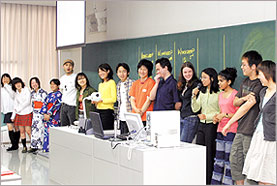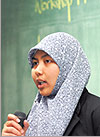 |


 |
An innovative course designed to help new students adjust to life on APU's multicultural campus was renamed this year to the First-Year Student Workshop. For the first half of the semester, the workshop featured lectures and discussions on intercultural communication that incorporated an array of illustrative real-life examples.
The first half culminated with a presentation competition on the theme of intercultural communication. The domestic and international students in the workshop worked closely together to hone their presentations, drawing on not only the things they learned in class, but also their own personal intercultural experiences.
|
 |

 |
 |
A request from the Mayor |
 |
In the competition, the students assumed the role of civil servants and presented ideas to the “mayor” of a hypothetical APU City. This mayor had assigned the following mission:
Upon the inauguration of APU City in the year 2000, APU signed a declaration that designated it a “city of international mutual understanding”. Significant progress has been made thus far in raising international awareness among its citizens. Your group is entrusted to carry out the following three tasks and report back to the Mayor of APU City.
| 1) | Analyze why international mutual understanding is considered to be so important. |
| 2) | Investigate current efforts to improve mutual understanding in countries, regions, cities or corporations whose people represent a wide range of cultural backgrounds. |
| 3) | Develop practical initiatives that promote intercultural mutual understanding in APU City, taking into consideration the city's unique social environment (dual languages of English and Japanese, citizens from approximately seventy countries and regions, etc.). |
|
 |
Intercultural communication starts outside the classroom |
 |
In the process of completing these three tasks, the domestic and international students in each group confronted a host of challenges arising from differences in language, culture, and individual values. The students soon discovered that intercultural communication plays a vital role, even in small groups. Diverse personal backgrounds—even among those who shared a language—were another source of friction. Through working together to reach a common goal, the students were able to get a glimpse of intercultural communication in action.
|
 |
TAs hit the spotlight |
 |
Teaching assistants for the First-Year Student Workshop moderate the bi-weekly discussion sessions. Each group is assigned one student TA who ensures that the discussions proceed smoothly. They were an invaluable source of advice and support, particularly in the sessions leading up to the presentation competition.
On the day of the competition, the TAs chaired the proceedings with finesse, directly addressing questions to the more reserved students and providing suggestions to stimulate discussion. |
 |
Entertainment value is not the sole criterion! |
| |
The students in the audience rated each presentation by checking off items on an evaluation form that outlined a set of strict criteria. The audience judged not only the content, but also the manner of delivery, such as clarity of the explanations and vocal projection. Presentations that were entertaining but lacking in substance received fair and dispassionate appraisal. |
 |
Group #13 receives high marks for their skit
|

 |
Naturally, each of the forty groups took its own unique approach to the same topic. The presentation styles were varied; some groups simply read a report, others performed folk dances in ethnic costumes, while others still used manga comics to express their ideas. It was a fitting testament to the cultural diversity found at APU.
Group number thirteen received high marks for skits in which two people find a lost wallet. Their back-to-back skits featured the same situation, but with a seemingly insignificant change leading to a strikingly different conclusion in the second performance.
Skit #1: A Japanese person and a foreigner find a wallet on the street. Both wish to deliver it to the police, but the lack of a common tongue results in a misunderstanding: one person says “I'll take it to the police,” as he picks up the wallet, but is stopped by the other pedestrian, who misinterprets the action as an attempted theft. Both people want to do the right thing, but the language barrier and the general lack of trust that exists between two complete strangers leads to an uncomfortable situation marred by doubt and suspicion.
Skit #2: Again, two pedestrians come across a lost wallet. This time, however, the two people communicate through broken English and hand gestures, and they are committed to both making themselves understood and to understanding the other person. The skit ends with the two taking the wallet, arm in arm, to the nearest police station.
Building on the lessons of their skit, the group proceeded to introduce several real-life organizations that have adopted innovative methods for fostering communication among people with diverse cultural backgrounds. It then proposed a plan for promoting intercultural understanding in the imaginary APU City.
Groups were scored based on how efficiently and effectively they conveyed their message within the allotted 20 minute time period. This particular group was highly regarded for grabbing the attention of the audience with an easy to understand dramatic performance, then explaining in clear terms─citing numerous examples─the practical benefits of their original plan. |
|
 |
 |
 |
|






| ・ |
First-year
students give insights into intercultural communication |
|
 |
<Education
at the graduate level> |
|
 |
 |
 |







